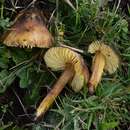Biology
(
Inglês
)
fornecido por Arkive
Fungi are neither plants nor animals but belong to their own kingdom. They are unable to produce their own food through the process of photosynthesis, as plants do; instead, they acquire nutrients from living or dead plants, animals, or other fungi, as animals do. In many larger fungi (lichens excepted) the only visible parts are the fruit bodies, which arise from a largely unseen network of threads called 'hyphae'. These hyphae permeate the fungus' food source, which may be soil, leaf litter, rotten wood, dung, and so on, depending on the species. Fruit bodies of the date waxcap appear following heavy rainfall (5) between July and December (1).
Conservation
(
Inglês
)
fornecido por Arkive
This fungus is a priority species under the UK Biodiversity Action Plan (UK BAP), and is included in English Nature's Species Recovery Programme. The Action Plan for this species aims to maintain all current populations through a number of measures. The lead partner for this species is Plantlife (5). Guidelines on minimising the impact of fungi collecting have been produced by English Nature (6).
Description
(
Inglês
)
fornecido por Arkive
Waxcaps are a group of fungi that have thick gills, watery flesh and a waxy texture (8). This waxcap has a brown, chestnut or coffee-coloured cap, which is slightly flattened but conical at first, becoming increasingly flattened in older specimens (1). The gills and the stem ('stipe') are bright yellow. The flesh is lemon yellow or yellowish white in colour, and the generic name Hygrocybe means 'moist head' (7).
WARNING: many species of fungus are poisonous or contain chemicals that can cause sickness. Never pick and eat any species of fungus that you cannot positively recognise or are unsure about. Some species are deadly poisonous and can cause death within a few hours if swallowed.
Habitat
(
Inglês
)
fornecido por Arkive
The often brightly coloured Hygrocybe waxcaps are generally associated with unimproved grassland (8). This species is found mainly on limestone pastures with a southern aspect, but has also been recorded from calcareous dunes and mown parkland (5).
Range
(
Inglês
)
fornecido por Arkive
The date waxcap is found throughout much of Europe. In the UK it occurs in scattered localities including parts of Wales, Cumberland, Shropshire, Devon and the island of Colonsay in the Hebrides (5).
Status
(
Inglês
)
fornecido por Arkive
Provisionally classified as Vulnerable in Great Britain (5). Digging up fungi without permission could constitute theft under the Theft Act 1968 (6).
Threats
(
Inglês
)
fornecido por Arkive
Although the historical and recent population trends of this species are not fully known, it seems likely that the following factors would have a detrimental effect on this species: changes in grassland management including fertiliser use and a reduction in grazing levels resulting in scrub invasion, trampling by humans, and vegetation succession on the dune sites (5).

